Research
 The evolution of parental care
The evolution of parental care
Parental care evolves when the benefits in terms of offspring survival are greater than the costs to the parents’ future reproduction. Care can be provided either by females, by males, or by both sexes. Which sex ends up caring for offspring depends partly on the balance of benefits and costs for each sex, and partly on historical constraints. Because of the costs involved, each sex would be better off if the other sex provides the care, so a conflict of interests between males and females is always present. The conflicts of interest in relation to who provides care become particularly acute when mothers cannot care for their own offspring, and in order to improve offspring survival they have no other choice but to find other conspecifics who will provide the necessary care. Very few model systems with obligate alloparental care have been studied so far.
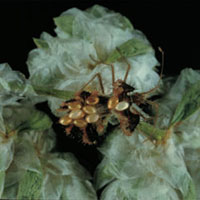 |
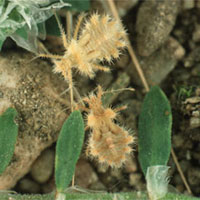 |
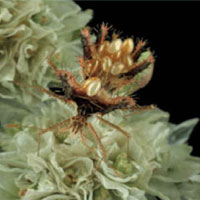 |
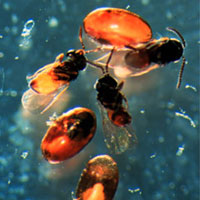 |
Female golden egg bugs (Phyllomorpha laciniata) face exactly this kind of situation because they cannot lay eggs on themselves, and yet egg carrying is of great benefit for egg survival. Females can lay eggs on plants (Paronychia argentea) where they develop unattended or on the backs of conspecifics where they remain firmly glued until the nymphs emerge and start an independent life. The survival rates of eggs laid on plants are very low as a result of high predation rates and attacks by an egg parasitoid wasp. On the other hand, when eggs are laid on conspecifics survival, rates improve considerably, mainly due to a decrease in parasitoid pressure (Reguera and Gomendio 2002). Females thus benefit from laying eggs on conspecifics and, when given the choice, have developed a preference to lay eggs on them rather than on plants (García-González and Gomendio 2003a). However, carrying eggs is costly because individuals become conspicuous and are easily detected by predators, while at the same time are less able to escape because the eggs tend to be glued on top of the wings and make flying difficult (Reguera and Gomendio 1999). Although females would benefit equally from laying eggs on males or females, because survival rates do not differ according to the sex of the caregiver, the patterns observed in natural populations show that egg carrying is more prevalent among males (Gomendio and Reguera 2001). Our data from the field show that 77 % of the eggs are carried by males, because more males than females carry eggs, and because males carry a greater number of eggs (García-González and Gomendio 2003b). Thus, egg carrying is performed predominantly by males and most eggs are laid on males by their current mating partner, sometime after copulation. This suggests that males are more likely to accept eggs than females. On the other hand, females carry 23% of the eggs, and in all cases they are unrelated eggs. Egg carrying by females could reflect low levels of intraspecific parasitism by females who try to oviposit on other conspecifics rather indiscriminately, in an effort to improve the survival of their offspring.
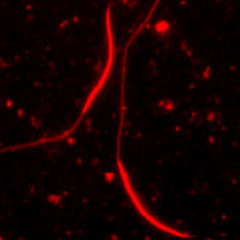 Care
by males is uncommon in most insects because male lifetime reproductive
success is mainly determined by the number of females with whom they mate,
and providing care frequently reduces to a great extent the opportunities
for looking for females and mating with them. In addition, males are expected
to provide care only when certainty of paternity is high. However, this
is not the case in the golden egg bug. Females are polyandrous and store
sperm in the spermatheca where sperm mixing takes place (García-González
et al. 2003). Males are likely to accept eggs, despite intermediate levels
of paternity, because they cannot discriminate in favour of their own
eggs, because rejected eggs will face 97% mortality rates on plants, and
because they do not suffer mating costs when they carry eggs. Males attempt
to improve their share of paternity by increasing both copulation duration
and sperm transfer when there are rival males present (García-González
and Gomendio 2004). Thus, males seem to accept eggs because the benefits
in terms of survival of their genetic offspring are greater than the costs
derived from carrying eggs of mixed paternity (García-González
et al. 2005).
Care
by males is uncommon in most insects because male lifetime reproductive
success is mainly determined by the number of females with whom they mate,
and providing care frequently reduces to a great extent the opportunities
for looking for females and mating with them. In addition, males are expected
to provide care only when certainty of paternity is high. However, this
is not the case in the golden egg bug. Females are polyandrous and store
sperm in the spermatheca where sperm mixing takes place (García-González
et al. 2003). Males are likely to accept eggs, despite intermediate levels
of paternity, because they cannot discriminate in favour of their own
eggs, because rejected eggs will face 97% mortality rates on plants, and
because they do not suffer mating costs when they carry eggs. Males attempt
to improve their share of paternity by increasing both copulation duration
and sperm transfer when there are rival males present (García-González
and Gomendio 2004). Thus, males seem to accept eggs because the benefits
in terms of survival of their genetic offspring are greater than the costs
derived from carrying eggs of mixed paternity (García-González
et al. 2005). Collaborators:
• Francisco García-González, Evolutionary Biology Research Group, The University of Western Australia (Australia)
• Fernando Ponz, Instituto Nacional de Investigaciones Agrarias, Madrid (Spain)
• Ana Rivero, Museo Nacional de Ciencias Naturales CSIC, Madrid (Spain)
Back to projects